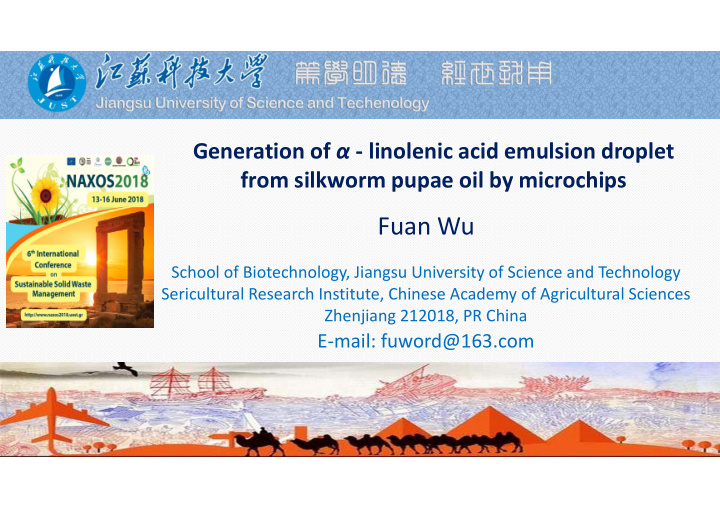



Generation of α ‐ linolenic acid emulsion droplet from silkworm pupae oil by microchips Fuan Wu School of Biotechnology, Jiangsu University of Science and Technology Sericultural Research Institute, Chinese Academy of Agricultural Sciences Zhenjiang 212018, PR China E ‐ mail: fuword@163.com
CONTENT 1 2 3 4 5 Background Previous study Present study Conclusion Acknowledgments
Background α - linolenic acid ω -3 polyunsaturated fatty acids An Essential Fatty Acid [1] Roger M. Loria, David A. Padgett. Journal of Nutritional Biochemistry, 8(3), 140-146 (1997)
Background Embroidery Silk Road Silkworm Silkworm pupae 0.5 Million tons/year Silk
Previous study Three Double Bonds Very Strong Reducibility How to prevent to be oxidized ? Easily to be oxidized
Effect of antioxidants on stability, nutritional values of refined sunflower oil during accelerated storage and thermal oxidation in frying Methods A NEW TECHNIQUE A Oxygen absorbents Drawbacks B Nitrogen filled protection Side effects of toxicity Poor thermal stability C Adding antioxidants into the oil
Dynamics of microfluidic droplets Fig. 1. Three passive methods for generating microdroplets [3] (A) T-junction microfluidic chip droplet formation method. (B) Flow-focusing microfluidic chip droplet formation method. (C)Co-flowing streams of microfluidic chip droplet formation method. The right parts are schematic illustrations of relative Methods. The colored area indicates the dispersed phase, and the arrow indicates the flow direction of the continuous phase. [3] Baroud CN, Gallaire F, Dangla R. Lab on a Chip, 2010, 10(16):2032 ‐ 2045.
Present study
Synthesis and characterization of caffeic acid grafted chitosan Fig. 2. FTIR spectra and structure assignment of chitosan and caffeic acid grafted chitosan
Effect of two-phase flow rate on droplet size Fig. 3. The relationship between the formation of droplets and the two different phases. (a) The relationship between continuous phase velocity and droplets size; (b) The relationship between dispersed phase velocity and droplets size; (c) The relationship between total velocity and droplets size.
Continuous phase 0.75 μ L/min Optimization of o/w emulsion process Disperse phase 0.45 μ L/min 0.1% Tween 20 Fig. 4 . Micrograph of emulsion containing Tween 20. (a) 0.1% Tween 20; (b) 0.25% Tween 20; (c) 0.5% Tween 20; (d) 1.0% Tween 20.
Morphology and crystallinity of α - linolenic acid microcapsules Fig. 5. SEM images of the α – linolenic acid microcapsules. (a) Caffeic acid grafted chitosan at X1000; (b) α - linolenic acid microcapsules at X2000.
Morphology and crystallinity of α - linolenic acid microcapsules Fig. 6. X-ray defractograms of chitosan, caffeic acid grafted chitosan and α - linolenic acid encapsulate.
The TGA of α - linolenic acid microcapsules 25 � to 800 � Table 1 Results of the TG analysis α - linolenic acid . Transition temperature (°C) Weight loss Residual No. of Sample at transition weight (%) transition T i T m T f (%) at 800 °C 1 26.59 54.81 102.80 5.30 2 102.80 147.68 166.23 5.51 3 166.13 224.33 255.27 24.82 83.82 ALA-M 4 255.27 291.57 367.68 24.90 5 367.68 401.89 504.57 15.10 6 504.68 604.01 793.22 7.83 Fig. 7. The TG analysis of α - linolenic acid microcapsules
Antioxidant activity of α - linolenic acid microcapsules The EC 50 values of DPPH experiments 90,0% 80,0% 70,0% 60,0% 50,0% 40,0% 30,0% 20,0% 10,0% 0,0% THE Α‐ LINOLENIC THE Α‐ LINOLENIC O/W DROPLETS
Conclusions The microfluidic droplet technique with anti ‐ oxidation wall material was constructed to 1 prepare monodisperse α ‐ linolenic acid microcapsules. The aqueous solution of caffeic acid grafted chitosan was used as the aqueous phase to 2 prepare monodispersed droplets of α ‐ linolenic acid by microfluidic droplet technology. The 0.1 % Tween 20 solution was used to prepare O/W droplets with an encapsulation 3 efficiency of 79%. This capsule obtained after drying was uniform size, stable morphology, good rheological 4 properties and high dispersion. 5 In addition, α ‐ linolenic acid microcapsules showed excellent antioxidant properties (EC 50 = 84.96 ± 4.05%).
Acknowledgments 01 01 The Natural Science Research General Project of Jiangsu Province Universities The Six Talent Peaks Project of Jiangsu (2017120206) Province (2015 ‐ NY ‐ 018) The Qing Lan Project of Jiangsu Province 02 02 (2014) 03 03 The Key Research and Development MORE MORE THEN THEN TEMPL TEMPLATE TE The Shen Lan Young scholars program of Program (Modern Agriculture) of Click here to add you to the center of the narrative thought Jiangsu University of Science and Jiangsu Province (BE2017322) Technology (2015) 04 04
Thank You Very Much For Your Attention !
More recommend